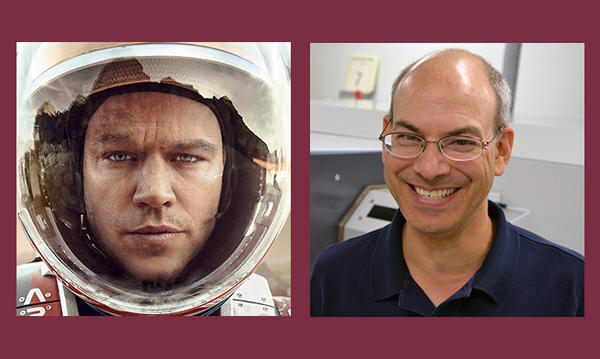
Florida State.
Hollywood and science come together when the upcoming blockbuster film ‘The Martian’ opens in theaters Friday, Oct. 2.
Set in the near future, the story revolves around astronaut Mark Watney (Matt Damon), who is presumed dead after a fierce storm and left behind by his crew during a manned mission to Mars. But Watney survives and finds himself stranded and alone on the hostile planet. With only meager supplies, he must draw upon his ingenuity, wit and spirit to subsist and find a way to signal Earth that he is alive.
Based on the novel by Andy Weir, the premise of the film begs the question, “Can humans really survive on Mars?”
Florida State University Professor Munir Humayun’s research at the National High Magnetic Field Laboratory — an analysis of an ancient Martian meteorite known as Black Beauty — is unlocking clues about the Red Planet that may one day help answer the question about life on Mars.
Humayun is a professor of geochemistry at Florida State University and on staff at the National High Magnetic Field Laboratory in Tallahassee. He has done extensive research on the geology of Mars through analysis of the Red Planet’s meteorites. Humayun’s work has been published in journals such as Nature, Science, Meteoritics & Planetary Science and Earth & Planetary Science Letters.
Humayun talked to FSU 24/7 about his research of the Red Planet and offered insight about the fictional scenario astronaut Mark Watney faces in “The Martian.”
What would be the first thing you would do if you were stranded on Mars today with no way to return to Earth?
Today, that would be a real disaster. My best bet would be to head to Gale Crater and commandeer the Curiosity rover. I could peer into the MastCam and give NASA a real shock!
If I can’t make it to Curiosity, I would have to place rocks into a huge SOS on the surface in the hope that the Mars Reconnaissance Orbiter could find my position — at least someday I could receive a proper burial in Arlington. After that, life on Mars will quickly become “solitary, poor, nasty, brutish and short.” You see Mark Watney had it good. By the time he got there, humans had left enough space junk that Watney could become the first Martian scavenger and make a temporary living on it.
What are the challenges to surviving on Mars?
Mark Watney’s challenge is to make enough oxygen to breathe, water to drink and grow food to eat.
All the oxygen will need to be made from scratch because the Martian atmosphere has levels of molecular oxygen comparable to a vacuum. Any water present is frozen at depth in the regolith (soil), so he needs an energy supply to thaw the frost to collect water. The only sustainable energy comes from solar panels which the movie trailer shows were conveniently jettisoned by the departing team.

The soil is rich in mineral nutrients but lacks any “humic” component — the dark rich stuff we buy in bags from the garden store to enrich the Georgia clay — as red as the Martian soil and nearly as difficult to grow plants in. The soil contains toxic perchlorates that have to be leached from the soil before it can be cultivated. The perchlorates could be used to generate oxygen gas by heating them, and the residual soil used to fill the terrarium in which plants are grown for food and oxygen production.
He will need to compost his plant waste in an isolated composter bin to leave spare oxygen for him to breathe.
Watney’s mission is scheduled for a date far enough in the future that oxygen generation equipment like MOXIE has become established to supply oxygen for humans. MOXIE will electrochemically manufacture molecular oxygen from the atmosphere of Mars that scientists will test during the Mars 2020 mission. If it works as planned it will be a huge step toward human habitability. The idea is that MOXIE-type equipment, will be established robotically on Mars in advance of human travel. I’m curious to know how Watney will handle the situation in the film.
What is the most interesting thing you’ve learned about the Red Plant through your research of the ancient Martian meteorite know as Black Beauty?
It’s a sedimentary rock masquerading as an impact melt breccia. Mars built its crust really quickly while the Earth took billions of years to perfect the job. This may have had to do with Earth holding on to its water. Mars lost its water very early — and I’m hoping to learn how much — while Earth still has it. Mars lost its magnetic field early, too, while the Earth has its magnetic field. Magnetic fields are the non-fiction version of “Star Trek” force shields that hold off oncoming death beams without which our comfortable terrestrial existence would also be short-lived. Some of the clasts in Black Beauty clearly formed on a muddy planet pounded by impacts from space. It’s such a rich and complex rock that I have scratched merely the surface, and that’s what motivates me to keep digging deeper into its secrets. The clues to Mars’ habitability may lurk within the clasts of Black Beauty.
What are the barriers to researching Mars?
Getting samples without which we can speculate but few will bet their lives on that speculation and make a living on Mars. Mars is a more challenging place to travel than the American West, the Sahara Desert, or even the Gobi Desert or Antarctica because those places have air to breathe. Right now, my hopes are on robots to help with getting enough coverage that we can safely send humans. Then, there’s the funding barrier. Sending a probe to Mars costs about a cup of coffee per day per taxpayer — per Bill Nye who has done all the accounting for this. But when Congress can’t pass a budget, the U.S. space program could end up like Leif Erikson’s first colony in the New World — a curiosity for future space archeologists, but all the credit for exploring Mars will go to those who gave it continuity. The U.S. will be forgotten to all but a few academics.
Do you think Earthlings will travel to Mars in the future — or maybe even colonize?
I’m sure they will. Mars is the next place to go after the Moon, and we didn’t find much to go back to on the Moon. Colonize Mars? I think so. Assuming that we don’t suffer a major population crash on Earth, we are running out of space, so to speak, and Mars is the only place to go (Mercury and Venus are not even remotely interesting from the real estate perspective) between here and Jupiter. We can’t live on the gas giants like Jupiter, Saturn, Uranus and Neptune — no solid surface, too much gravity are a bad combination — but the moons of Jupiter might offer a refuge. Otherwise, it’s a 40,000 year trip to the closest stellar system and no guarantees that there will be a habitable planet and that the natives will be friendly at least towards us wonderful Earthlings.
Would you travel to Mars if you were given the opportunity?
Given the opportunity, I’m ready to travel to Mars when they are ready to open their first microbrewery. I love my creature comforts.




